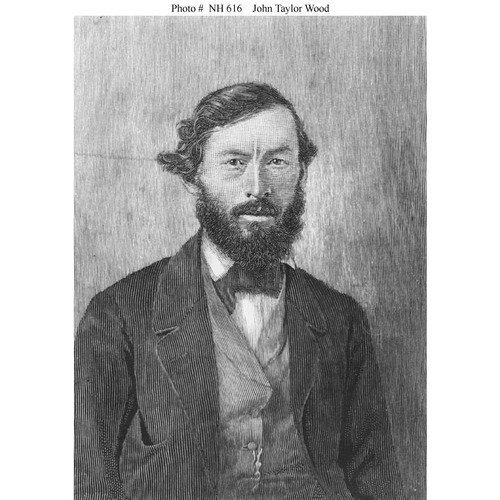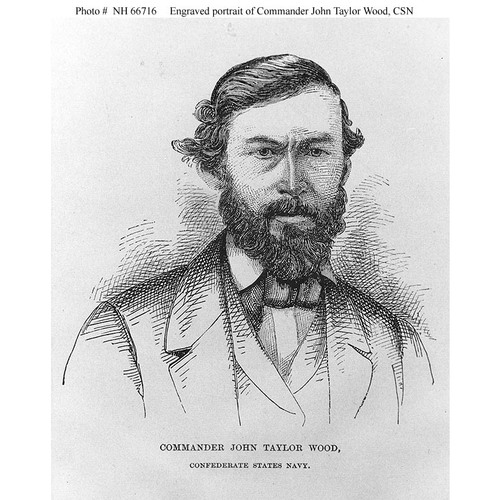
Source: Link
WOOD, JOHN TAYLOR, Confederate naval officer, merchant, and insurance broker; b. 13 Aug. 1830 in Fort Snelling (Minneapolis-St Paul, Minn.), son of Major Robert Crooke Wood, an American army surgeon, and Anne Mackall Taylor, daughter of Zachary Taylor, later president of the United States; m. 26 Nov. 1856 Lola Mackubin, and they had 11 children; d. 19 July 1904 in Halifax.
John Taylor Wood grew up at a series of army posts in the American Midwest. In 1847 he entered the United States Navy and in 1853 he graduated from the Naval Academy at Annapolis, Md. After service at sea, he returned to the academy in 1860 to become an assistant instructor in naval tactics and gunnery. When the Civil War erupted Wood broke with his father and father-in-law by accepting a commission in the Confederate navy. Early in 1862 he won fame as a gunnery officer on board the Virginia, which fought to a draw with the Monitor in the first confrontation ever between armoured warships.
During the next two years Wood engaged in operations against Union vessels blockading the coasts inside Chesapeake Bay. His achievements resulted in his being named naval aide-de-camp to his relation through marriage Jefferson Davis, president of the Confederacy, and then commander of the Tallahassee, a British-built steamship thus far used as a Confederate blockade runner. Fitted with cannon, this, perhaps the fastest vessel afloat, stole out of Wilmington, N.C., on 6 Aug. 1864 and proceeded in one foray up the American coast to capture and destroy some 25 Union merchant and fishing craft. The raid caused panic in shipping circles and doubled marine-insurance rates. On 18 August the Tallahassee put into Halifax to make repairs and take on coal.
Although Wood obtained assistance in Halifax from local pro-Confederates such as William Johnston Almon and Benjamin Wier*, he also had to contend with hostile British officials who insisted, in accordance with neutrality regulations, that the Tallahassee leave after 24 hours. The deadline was later extended but, thanks to pressure from the government in Washington, Wood was prevented from taking on more than a minimal amount of coal. Because Union vessels were known to be sailing towards Halifax, Wood decided to escape at night by the shallow, twisting passage to the east of the main islands in the mouth of Halifax Harbour. The escape was made possible by the skill of a local pilot, John Flemming, and by the Tallahassee’s twin propellers, which allowed it to make the sharp turns necessary in order to stay in the middle of the channel. But Wood’s daring breakout was in fact pointless, since he left four hours before the Union warships arrived. Had he been allowed to take on a full load of coal his gamble would not have worked because the Tallahassee’s draught would have been too great for the channel. Short of fuel, Wood was forced to abandon raiding and return to Wilmington. Ironically, his exploits led to the effective Union closure of the port, the Confederacy’s last important link to British sources of supply.
Having become something of a hero, Wood was promoted captain and again served as an aide to Davis. When the rebellion collapsed in 1865, he made another celebrated escape, this time to Cuba. From there he proceeded to Halifax. Assisted by Almon and Wier, an inheritance from his father, and loans from his mother, he became a wholesale merchant in partnership with John Wilkinson, another former Confederate naval officer. Wilkinson soon went back to the United States but Wood remained in Halifax, where he speculated in real estate, served on the Chamber of Commerce, and became a director of the Block House Coal Mining Company and the Atlantic Marine Insurance Association. Unfortunately, he could not escape the effects of the onset of hard times in the mid 1870s, and around 1886 he failed as a merchant and lost most of his property. Nevertheless, sustained by an 1874 appointment to the Halifax Pilot Commission and by what he could make as agent for the Boston Marine Insurance Company, Wood continued as a member of polite society. He figured prominently in yacht races, and as early as 1871 had become vice-commodore of the Royal Halifax Yacht Club.
Wood’s death in 1904 was front-page news in Halifax, and the local press used the occasion to retell the story of the Tallahassee, quoting from his account of the episode. Although Wood died an American citizen, the imperialistic mood of the times, reinforced by the service of one of his sons in the North-West rebellion and the death of another in the South African War, transformed the erstwhile Confederate patriot into a hero for Edwardian Nova Scotia. Wood’s memory has been kept alive there; his account of the escape was for a long time part of school readers, and a school near his escape route is named after his ship.
A portrait of John Taylor Wood appears in Canadian album (Cochrane and Hopkins), 3: 97. His account of the Tallahassee incident was published under the title “The ‘Tallahassee’s’ dash into New York waters,” Century Illustrated Monthly Magazine (New York and London), new ser., 34 (May-October 1898): 408–17.
Baker Library, R. G. Dun & Co. credit ledger, Canada, 12: 685, 788 (mfm. at NA). Halifax County Court of Probate (Halifax), Estate papers, no.5983. Halifax County Registry of Deeds (Halifax), Deeds, 165: f.8; 168: f.43; 181: f.93; 182: f.44; 197: f.14. Acadian Recorder, 13 May 1893; 30 May, 6 June 1896; 19, 21 July 1904. Evening Mail (Halifax), 19 July 1904. Halifax Reporter, 18–22 Aug. 1864. Morning Chronicle (Halifax), 12 May 1896, 20 July 1904. Almanac, Belcher’s, 1860–90. DAB. Directory, Halifax, 1869/70–1904. J. L. Wakelyn, Biographical dictionary of the Confederacy (Westport, Conn., 1976).
Cite This Article
David A. Sutherland, “WOOD, JOHN TAYLOR,” in Dictionary of Canadian Biography, vol. 13, University of Toronto/Université Laval, 2003–, accessed December 12, 2025, https://www.biographi.ca/en/bio/wood_john_taylor_13E.html.
The citation above shows the format for footnotes and endnotes according to the Chicago manual of style (16th edition). Information to be used in other citation formats:
| Permalink: | https://www.biographi.ca/en/bio/wood_john_taylor_13E.html |
| Author of Article: | David A. Sutherland |
| Title of Article: | WOOD, JOHN TAYLOR |
| Publication Name: | Dictionary of Canadian Biography, vol. 13 |
| Publisher: | University of Toronto/Université Laval |
| Year of publication: | 1994 |
| Year of revision: | 1994 |
| Access Date: | December 12, 2025 |




